For my next video, I try to remember how to setup and use a 37 year old dot matrix printer. How many mistakes can I make trying to print a short ClarisWorks 2.0 document from a Mac Classic II?! You will have to watch to find out.
-
-
Rough Road Ahead for Wireless CarPlay Upgrades
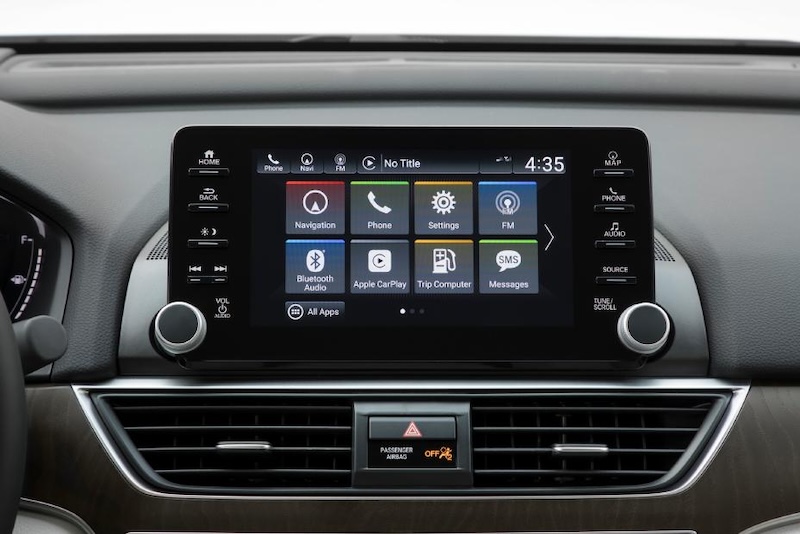
Photo Credit: Honda.com Last month, Honda announced that the company would make a dealer installed upgrade available for model year 2018 – 2022 Accord vehicles to add Apple’s wireless CarPlay feature. (The same upgrade adds support for wireless Android Auto also.) The cost of the upgrade kit will be $112 MSRP plus technician labor charges.
This software only upgrade is great news for owners like me who have a 2019 Accord with wired CarPlay. I mean, a wire! In 2024! The struggle is real.
To me, the press release announcing the upgrade kit is validation of what I had expected all along: the 2019 Honda Accord line of vehicles had all of the internal hardware that could have supported wireless CarPlay, but that Honda chose not to make the feature available. Whatever the internal decision making process might have been, a global pandemic, snarled computer chip production lines, and waitlists for a new Accord likely convinced Honda to change their thinking on older model upgrades.
From the official press release, Honda states that “[t]his quick software update enables customers to leverage hardware already in their Honda vehicle to enjoy seamless connectivity through wireless Apple CarPlay” and that this upgrade is “a key strategy in pursuit of our goal to have zero environmental impact by 2050.”1
Getting Ready for the Upgrade
If you are reading this blog, you know I’m a computer nerd. You’re probably a computer nerd too. I have no idea about car people react to changes like this or how quickly the network of Honda dealers could roll out an upgrade like this. My Accord needed an oil change, so I called one of my local dealers and asked if they could do the oil change and the software upgrade at the same time. I was assured that the upgrade could be done, but that I should bring the car in during the week to avoid the Saturday rush. The cost of the software upgrade would be $120. I made the appointment for two days later.
Service Day
Potholes started appearing on the information superhighway when I arrived at my dealer. First, I was told that I needed to leave the car for the day as the software upgrade would take several hours because the update needed to be downloaded to the car via the satellite radio connection. That didn’t sound like a “quick software update” to me. Still, I really wanted wireless CarPlay in my Accord, so I agreed.
After getting a ride to work, the dealer’s service center called me to tell me that the total cost of the upgrade would be $270! The price increase was due to the wireless CarPlay upgrade kit software license ($120) plus one hour of labor ($150). I asked if I could buy the upgrade kit and do it myself and was told that it was a dealer-only install option. I was annoyed, but the excitement and satisfaction of having CarPlay in my Accord overtook me and I approved the work.
It Gets Worse
About three hours later, I received another call from the dealer. Things were not good. I was told that the software upgrade was attempted on my Accord via a USB flash drive and that it had failed. The dealer called the Honda support center, and they weren’t able to resolve the issue either.
Asking about the software upgrade process, I came to learn that this wasn’t a patch to CarPlay, but a full infotainment system OS upgrade to a newer version of Android Automotive – the software that many car manufacturers use in their infotainment systems. Android Automotive is able to “project” CarPlay and Android Auto (a completely separate CarPlay-like feature for Android smartphones) on the in-vehicle infotainment screen(s).
It was the OS upgrade that crashed and couldn’t be restarted. In its current failure mode, the radio head unit was completely unresponsive and would not turn on. In computer terms, we call that “bricked”. None of the vehicle functions that use the infotainment system worked. No AM or FM radio. No satellite radio. No backup camera. No auxiliary input. No wired CarPlay. Obviously no wireless CarPlay. No iPhone charging. Nadda. In other words, “She’s dead, Jim.”
This was not good. Seeing out the back window of a 2019 Accord is difficult and, in my opinion, really requires the assistance of a backup camera. Since they couldn’t get the radio head unit to respond to any maintenance commands and could not turn it on, the entire head unit needed to be replaced.
Thankfully, it will only be about a week before the replacement service can be performed. I couldn’t help myself. I had to press the poor service department staffer harder. “This replacement head unit is going to come with the new Android Automotive software preinstalled so that I will have the wireless CarPlay feature, right?” We both knew that the service staffer couldn’t answer the question and that the head unit that would be pulled off an inventory warehouse shelf wasn’t going to have the upgrade.
Furthermore, I was later told that it took three attempts to upgrade another compatible used Accord on the dealer’s lot and that Honda wanted all dealers to install the upgrade on every compatible used Honda Accord in inventory.
Based on the headaches I caused the dealer’s service department crew; the general manager told me that he was shutting down all future upgrades and was not installing the software update on any other Accords in their inventory.
So Now What?
What this story reveals is that software is hard. It’s hard for nerds like us. It is harder still for service techs who aren’t properly trained on how to install and support the software. And it is absolutely disastrous for dealers and customers when the software is so poorly tested that it is bricking the entire infotainment system in such a way that Honda has to cover the cost of replacing them.
For now, I am driving my Accord around and singing to myself. I’m also backing up carefully. Hopefully, the replacement part(s) will arrive at the dealer this week and we can schedule another full day of service to have the new unit installed in the car.
I would have loved to have seen the documentation and the upgrade process, but the general manager wasn’t going to let me anywhere near any of the official upgrade materials.
I will post a follow up when the issue is resolved. In the meantime, I need to get working on my singing voice.
- By 2050?! How many of the current automobile executives do you really think will still be working at Honda in 2050? Talk about kicking the can down the road. Environment?! It’s someone else’s problem. And that’s the problem – no one wants to take up this issue now. ↩︎
-
HomePod mini Troubleshooting Hijinks
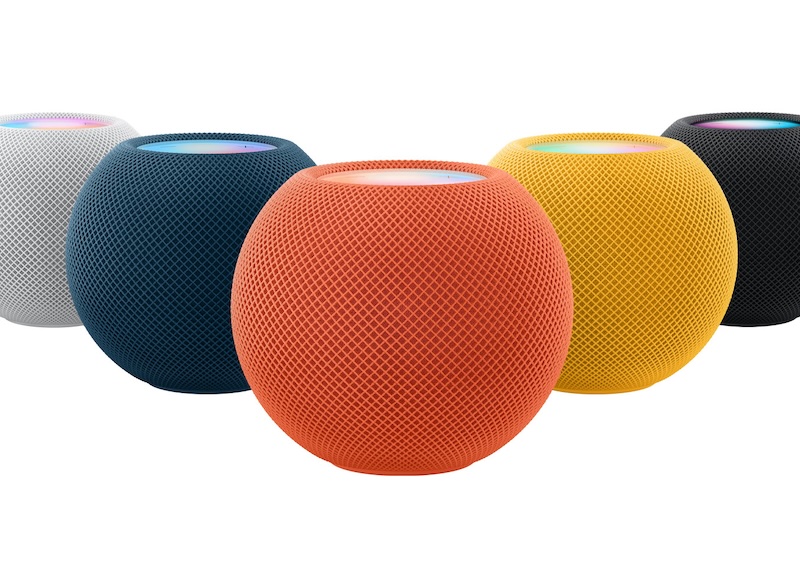
Yes. I admit it. I bought another HomePod mini. This time, I wanted to do something very specific with it – create a stereo pair with my older HomePod mini and use that stereo pair with my Apple TV as replacement speakers when watching movies and TV shows that I purchased from the thing formerly known as iTunes.
1While attempting to add my new HomePod mini to my digital home setup in the Home app, my new HomePod was getting stuck at the “Downloading” or “Configuring” stages. The other four Home Pods – two original “biggies” and two current HomePod minis – joined the Home app with no issue. But not HomePod #5. This is a common occurrence based on the Apple support forums threads and how-to explainers.
Adding to the knowledge base that is the Internet, here is how I fixed my issue with a current generation HomePod mini (2020), iOS 17.2.1 (21C66) on iPhone 15 Pro, and Mac OS Sonoma 14.2.1.
- Unplug all of the Home Hub devices (HomePods and Apple TVs) in your setup except the new HomePod and the device you want to be the “active” (my word) Home Hub. You can leave other HomeKit and Matter devices like lights and thermostats connected.
- Load the latest version of HomePod OS on the stuck HomePod. Depending on how your HomePod is stuck, you may need to hard reset it first. Then, connect the HomePod USB-C cable into your Mac. An orange/red light will start swirling on top of the HomePod.
- After a few minutes, double-click the Macintosh HD icon on your desktop to open a Finder window. Click on the HomePod text link in the left column.
- Use Finder to Restore the HomePod. Full directions are available on Apple.com. In my case, the HomePod shipped with HomePod OS 15.4 (released 3/14/22) meaning my new HomePod mini was sitting on a shelf for a long time. The upgrade process to HomePod OS 17.2 took less then 10 minutes.
- Disconnect the HomePod after the upgrade is complete. I put my HomePod mini back on the TV stand. Unplugging and replugging in power restarted HomePod mini. I also plugged in the HomePod mini I wanted to make the other half of the stereo pair.
- Using my iPhone, run the HomePod setup wizard again.
- After a successful setup, you can then go back around your home and plug in your other Apple TVs and HomePods.
All told, it took me six attempts and several hours to get everything setup. After creating the stereo pair “TV Pods”, I ended up having to reboot both HomePod minis, the family room Apple TV, and my iPhone 15 to get everyone on the same “page” an agree that there was in fact a stereo pair of HomePod minis called “TV Pods” made of up “Left TV Pod” and “Right TV Pod”.
The entier process was messy and very frustrating for a day after Christmas project. In my opinion, HomePod (hardware, software), Apple TV (hardware, software), and Music (app, service) are third-class citizens after iPhone, subscription services revenue, and the Mac.
Hopefully, this post will help save you some time and aggravation setting up your next HomePod.
-
Apple App Clips in the Wild
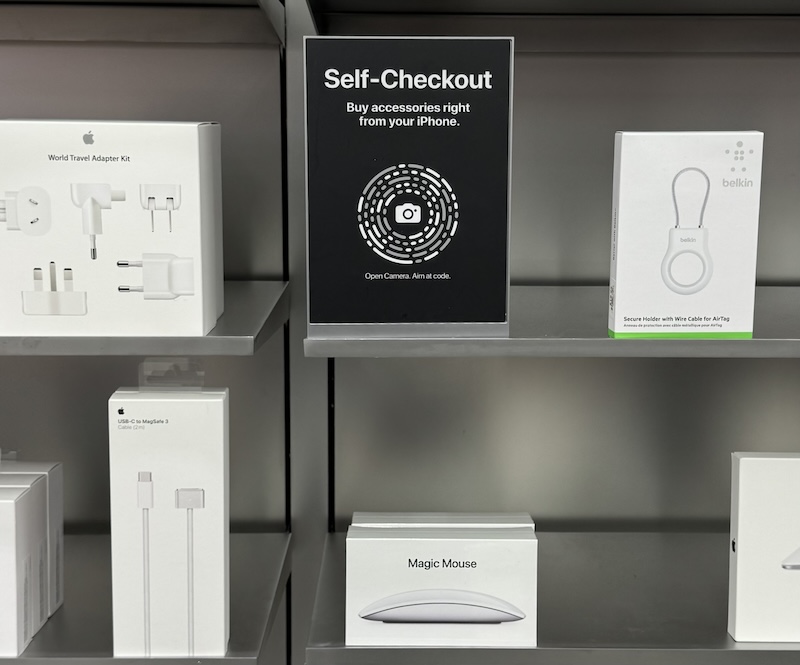
You will be forgiven if you don’t remember App Clips feature that was released as part of iOS 14 (Sept. 2020).
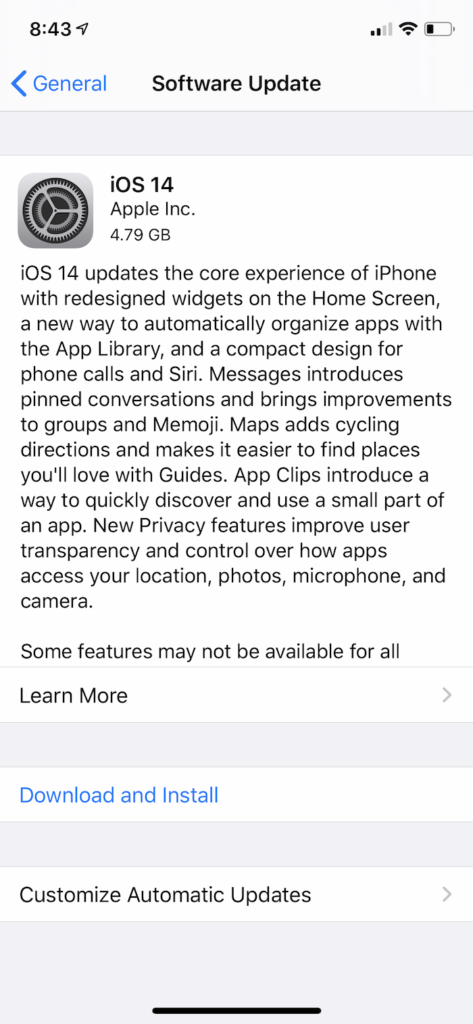
App Clips is a feature that loads a small sub-set of functionalities of apps in the App Store to complete a transaction without having to find, install, setup, and then use the app. The examples often cited by Apple include transactions like paying for take-out meals, renting bikes or scooters, or setting up a home automation device.
The whole point of an App Clip is to speed things up for customers who do not have your app installed. To Use an App Clip, you pull out your iPhone, open the Camera app, and point the lens at a QR-like code that only Apple would take that the time to make look good and work well.
Up until now, the only place that I have seen App Clips used was in Apple Stores on the accessories walls.
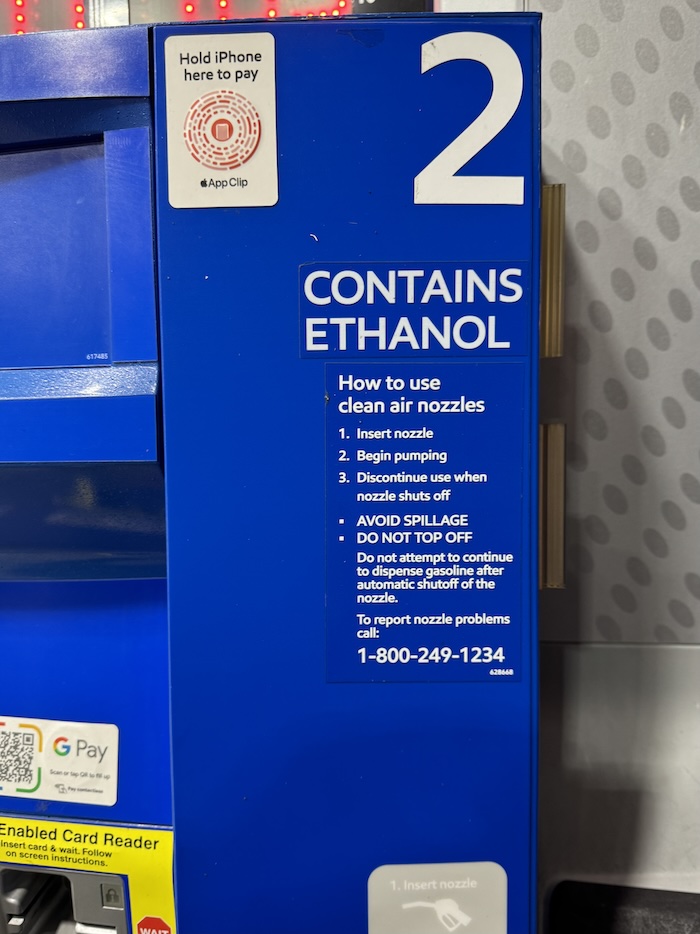
While running around in the pre-Christmas hustle and bustle, I needed to stop to put gas in the car. While filling up at an area self-service Exxon Mobil station, I noticed an App Clip sticker on the pump.
Here’s how the process works:
- Scan the App Clip icon with the Camera app.
- Tap on the yellow Exxon Mobil pill button to start the App Clip.
- Tap Open.
- Use Sign In with Apple to use your payment options in Apple Wallet.
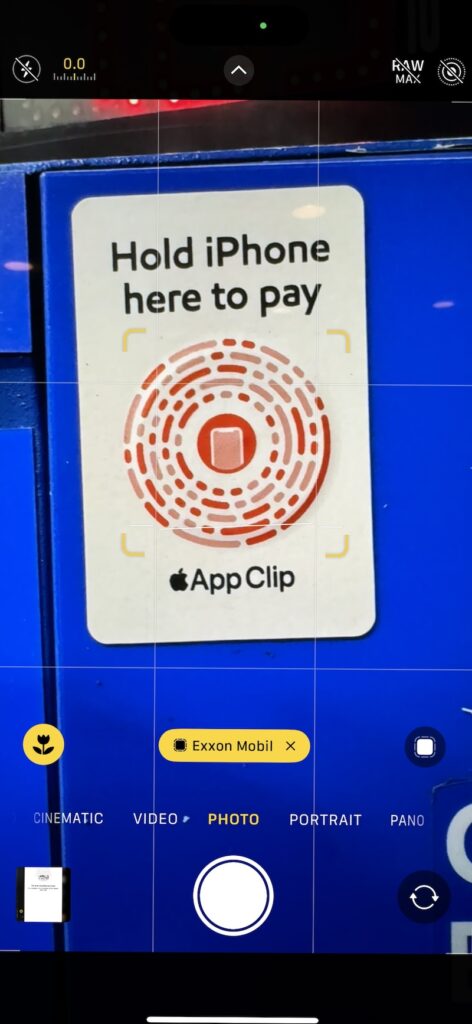
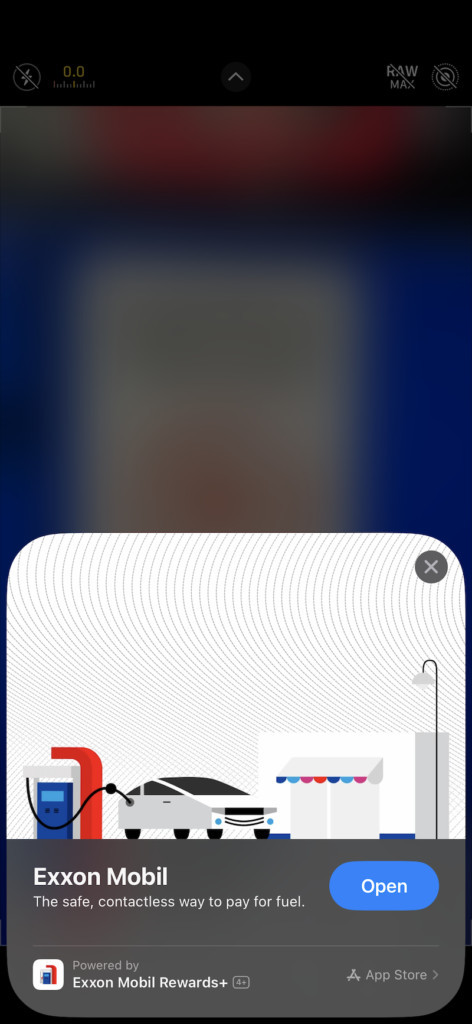
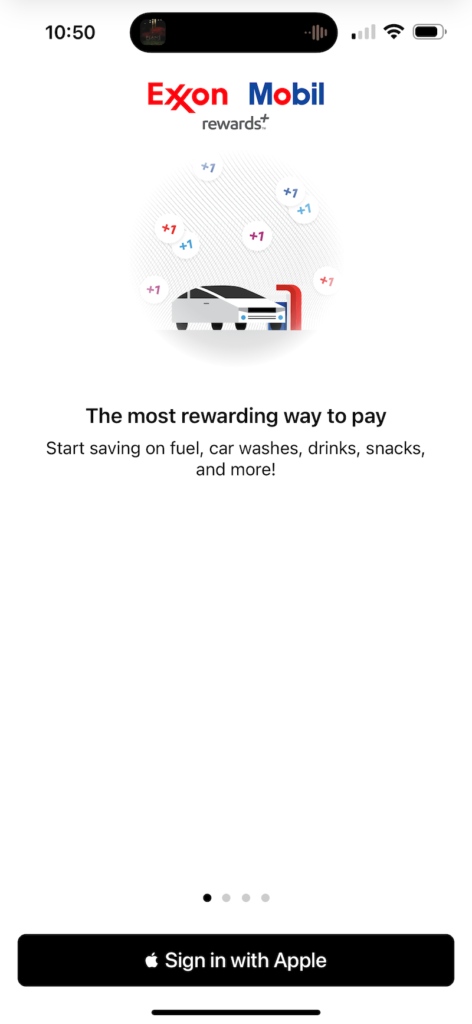
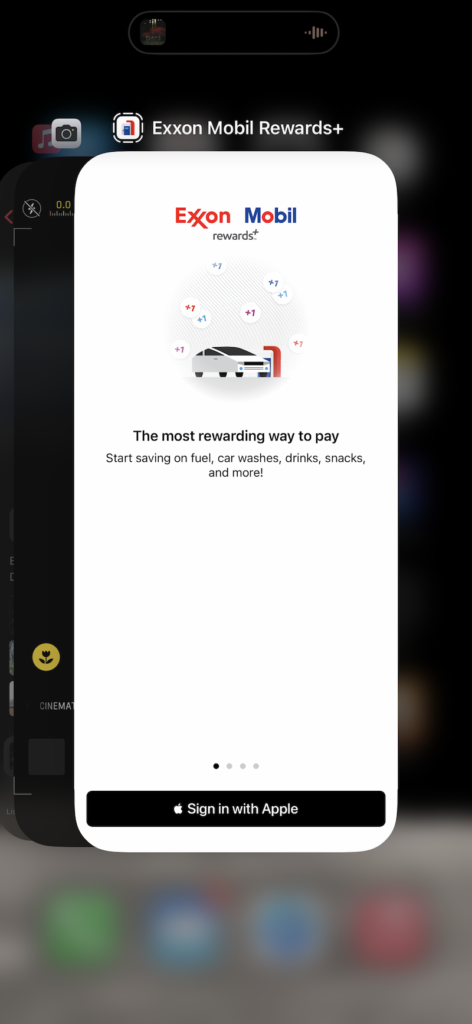
One real world use for App Clips that I wish was available is when I need to park my car downtown. There have been two occasions this month and at least one next month were I will need to park my car in a public parking garage. It would be really nice to have the App Clip option to pay for parking. Unfortunately, the company that manages this parking garage hasn’t added App Clip support to their app yet. -
Happy iPhone 15 Day!
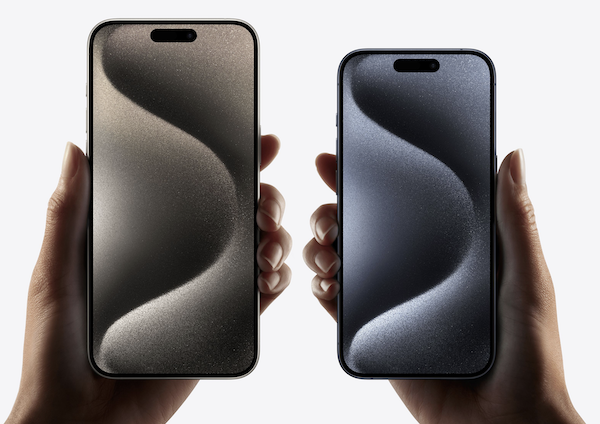
Today is the day that Apple fans have been waiting for all year long: iPhone 15 Launch Day!
You can follow our pick up adventure with the iPhone 15 playlist on my YouTube channel.
My Dad and I will be picking up our new iPhones at our local Apple Store this morning. For folks who pro-ordered like we did, I hope your pickup experience goes well.
For folks who are hoping to score a new iPhone 15 today, I hope that you are able to find the iPhone in the color and size that you are looking for.
Have a great day everyone, and congratulations on your new iPhone purchase!
-
Happy iPhone 15 Pre-Order Day
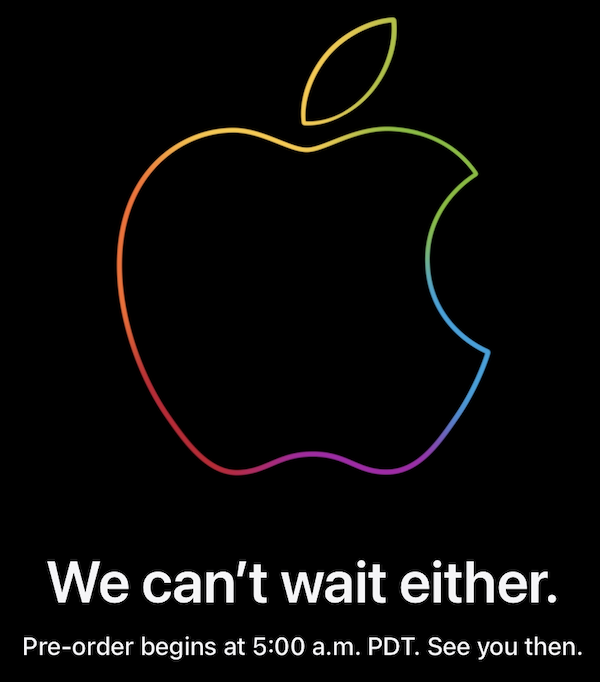
Today, Sept. 15, at 8:00am Eastern, the one true time zone in my opinion, Apple will begin taking pre-orders for iPhone 15 and iPhone 15 Pro. You will be able to pre-order your iPhone using the Apple.com website, or via the Apple Store app on your current iPhone.
This year’s iPhone 15 line up has a similar pricing ladder as last year.
iPhone 15 $799
iPhone 15 Plus $899
iPhone 15 Pro $999
iPhone 15 Pro Max $1,199Last year’s iPhone Pro Max 128GB storage tier has been dropped and the 256GB storage tier has remained at the same price. So, in effect, the iPhone 15 Pro Max has gone up $100 in price if you wanted then 128GB version or has stayed the same year-over-year if you go for the 256GB tier like I do.
People who get their pre-orders in this morning will likely be able to reserve their new iPhone 15 for in-store pick up or delivery next Friday, 9/22.
Good luck to everyone who will be pre-ordering today! I hope you get your pick for launch day.
-
How-To: Open a Sony MPF52A Floppy Drive
I have been working on restoring an Apple Power Macintosh 7100/80, first released in 1994. While tearing it down to remove the original PRAM battery from 1994, I decided to also pull out the 3.5-inch floppy drive to service it before attempting to power on the Mac.
What I discovered was that I couldn’t find any documentation (service manual, blog post, YouTube video) about how to open the drive without breaking the plastic faceplate. So, I made a video of me fumbling around trying to open the drive so you don’t have to wonder how to open it or break any plastic clips.
-
EU to Mandate Replaceable Batteries by 2027
While flipping through Mastodon on Sunday morning, I saw a toot linking to an article on Mashable.com written by Cecily Mauran covering a new European Union legislation that all batteries sold in devices must be end-user replaceable by 2027 and contain 80% recycled materials by 2031.
There are two benefits to this new regulation as I see it.
- Foster customer right to repair efforts to reduce e-waste
- Conserve and recycle natural resources, reducing greenhouse gas emissions
Directive 2008/98/EC and Regulation (EU) 2019/1020
The new law is part of Directive 2008/98/EC and Regulation (EU) 2019/1020. In the updating of the Directive and Regulation, Directive 2006/66/EC is now considered repealed.
The legislation rightly identifies the growing global demand for batteries as a long-term trend.
“In view of the strategic importance of batteries, to provide legal certainty to all operators involved and to avoid discrimination, barriers to trade and distortions on the market for batteries, it is necessary to set out rules on the sustainability, performance, safety, collection, recycling and second life of batteries as well as on information about batteries for end-users and economic operators. It is necessary to create a harmonised regulatory framework for dealing with the entire life cycle of batteries that are placed on the market in the Union.”
The legislation also states that laws governing the management of waste batteries must also be updated “to protect the environment and human health by preventing or reducing the adverse impacts” of batteries.
As someone who support climate science and initiatives to reduce carbon emissions that are warming the earth, I applaud the EU’s effort to build a sustainable circular battery supply chain.
EU Regulatory Impacts to iPhone
But what about us here in the United States? In my opinion, the absolute breakdown of the Congress to actually negotiate on bills and pass legislation means that there will be no unified federal regulations about battery reuse on par with the EU’s efforts. Rather, we here in the US will be left with a patchwork effort by states and corporations to advance greenhouse gas emission reduction and meaningful recycling programs.
To understand the impact to us here in the United States, I looked to another EU regulation, making USB-C the common device charging standard.
While this regulation does not directly apply to the US, it is an open secret at this point that Apple will finally switch the iPhone to USB-C, replacing the Lightning port after an 11-year run. It is cheaper for Apple to switch the iPhone to USB-C than to try and maintain a USB-C iPhone to be sold in the EU and a Lightning iPhone to be sold everywhere else. In other words, there is a financial incentive for Apple to get on board with USB-C for charging and sync’ing data. I applaud this decision as the iPhone is effectively the only electronic device that I use daily that does not already use USB-C for charging. In my opinion, the move to USB-C from Lightning on the iPhone was long overdue.
It’s easy to get behind an EU ruling when you agree with the position they are taking. But what about rulings that you don’t agree with? Am I as willing to accept that EU rules can change the iPhone I use every day in a detrimental way? Let’s take a more reasoned approach to my initial thinking.
User Replaceable Batteries Alone Won’t Make iPhone Thicker
My first reaction to this new EU regulation was, “I don’t want a thicker, heavier iPhone”. My mind instantly went to the Palm Treo 700p, the Blackberry Curve 8330, and Android devices. They were all like carrying around bricks when set down on a table next to the original 2007 iPhone.
Consider the thickness (depth) of these mobile devices:
Smartphone Depth Weight Palm Treo 700p (2006) 0.89″ 181g Apple iPhone (2007) 0.46″ 136g BlackBerry Curve 8330 (2007) 0.59″ 113g Apple iPhone 6 (2014) 0.27″ 129g Apple iPhone 6 Plus (2014) 0.28″ 189g Apple iPhone XS Max (2018) 0.30″ 208g Google Pixel 6 (2021) 0.4″ 207g Apple iPhone 14 Pro Max (2022) 0.31″ 240g Samsung Galaxy S22 Ultra (2022) 0.35″ 228g Having reached what I call “Peak Thinness” with 2014’s iPhone 6 and the ridiculous “bendgate controversey” that went along with it, I cheered for the internal battery. A Treo 700p is comically thick compared to the iPhone 6. The thought of putting a user replaceable battery into the iPhone for the first time gave me shivers as I began thinking about battery doors, clips, and a big ol’ chunk battery like the ones used in early smartphones.
But looking at the technical specifications of the smartphones listed above, they are already getting bigger, thicker, and heavier.
With this trend in smartphones, and I’ll speak specifically to the iPhone, might some of the world’s best mobile device engineers be able to simultaneously add features and accommodate an end-user replaceable battery? I think it could be possible in 3 – 4 years.
With the iPhone 15, the next iPhone that is expected to be released in September 2023, Apple is already rumored to be making slight body changes. iPhone 15, as mentioned earlier, is rumored to have a USB-C port, which is physically larger than Apple’s proprietary Lightning port. More powerful camera lens systems also necessitate a thicker body. Anyone else remember when the iPhone 4 would lay flat on its back on a table relative to the seesaw that is a recent generation iPhone on its back? Apple is also rumored to be making a switch from stainless steel bans on iPhone Pro models to the lighter medal, titanium, in an effort to offset weight from a larger battery.
We will see what pans out in September, but with a clear trend line that iPhones are getting thicker and heavier, it would seem there is some wiggle room to add hardware changes to support a battery that is easier to replace.

The inside of an iPhone 14 packed wall-to-wall, as can be seen in the photo (above) taken from the Apple iPhone 14 Repair Manual. To remove the battery, one must first remove the back glass to open the iPhone, a procedure that requires the use of a complicated desk mounted contraption. While I am not a mechanical engineer, making the iPhone easier to open seems like a good place to start to make battery replacement easier.
If Apple really doesn’t want to put a user replaceable battery in the iPhone, without the need for complicated equipment, they could just go back to lowering the price for battery replacements to make the repair more accessible to customers. The price of battery replacements dropped to a low of $29 in 2018 following customer lawsuits in 2017 relating to Apple slowing down performance of older iPhones that had aging batteries in them. In 2019, Apple raised battery replacement prices and did so again earlier this year, erasing all of the temporary price reductions put in place in 2018.
Wrap Up
Apple has shown that they can achieve amazing feats of engineering to deliver products that many of us want to buy. But as we will see with the first USB-C iPhone, sometimes that willingness to change and re-invent things requires a little help from world governments. My initial reaction to easily replaced iPhone batteries was likely overblown. With the right motivation and lots of engineering effort, I believe it is possible to keep iPhones from getting overly larger and heavier and still have a battery that is easier to replace than the current process.
-
2023 Mac Pro Completes Apple Silicon Transition

The 2023 Mac Pro is a massively powerful Mac, however, anyone seriously considering buying this machine for work needs to understand what it can and can’t do for them.
With the release of the new 2023 Mac Pro earlier this month, Apple completed their CPU transition from Intel CPUs to their own in-house designed Apple Silicon chips. To call Apple Silicon chips “CPUs” is a bit of a misnomer as these chips really are whole System on a Chip (SoC) designs encasing the CPU, GPU, RAM, Neural Engines, Secure Enclave, video encoders and more. From my “old man” view, the Apple Silicon is like the whole system board, or motherboard if you’re from the PC camp, all rolled up into a single chip on today’s Macintosh computers. (Side Note: The Apple II series system board was referred to as “the circuit board” in Apple documentation in the late 1970s into the early 1980s.)
The transition from Intel to Apple Silicon was originally stated to take two years by Tim Cook. Having lived through the PowerPC and Intel transitions already, I was not surprised with a two year timeframe. Apple is a company that knows how to do this sort of thing very well. The transition, clearly derailed by a global pandemic, ended up taking three years. Overall, not to bad, in my opinion. However, by the end of Apple’s March 2022 keynote address, the 2019 Mac Pro was already started to feel past it’s sell by date when John Ternus would hint that more news was coming soon about the Mac Pro. As it turned out, it would be another 14 months before the new Apple Silicon Mac Pro would begin shipping to customers. Years from now, I would love to read about what happened to this version of the Mac Pro. Clearly something went wrong and the project needed to be recalibrated. Perhaps, the design of this machine will become an Apple University lesson.
The 2023 Mac Pro, now shipping to customers, is Apple’s highest of high-end machines. It comes equipped with the highest of high-end SoC chip to date: the M2 Ultra. And a price tag to prove it. The Mac Pro starts at $6999. If I was able to use Uncle Tim’s Apple Card, the Mac Pro configuration I would order (base M2 Ultra, 128GB RAM, 4TB SSD) comes in at $8,799 or $733/mo for 12 months. By comparison, my M1 Pro Mac Studio was a bargain at just $2,999. Apple also announced the the M2 Max, which is available in updated MacBook designs. These new chips join the base M2 SoC released in January.
On the outside, the new Mac Pro looks almost exactly the same as the previous Intel model, which is completely fine in my opinion. I’m sure Apple chose to re-use the exterior case design as a means to recoup design costs. I like the idea of having expansion bays so that you can stuff it full of expansion cards. Just like I used to do with my Apple //e. But that’s my old man is showing again. I meant, my PowerMac G4. Whoops, I did it again.
Unlike the previous Mac Pro, the 2023 Mac Pro allows you to add cards to it, as long as those cards aren’t the Afterburner card or a third-party graphics card. The former is now supercharged and baked into the M2 Ultra chip. The latter just isn’t an option because Apple thinks that their M2 Ultra GPU cores are just as capable and are “on package” in the SoC. You can discuss amongst yourselves about whether or not third-party off SoC package video cards could or should be supported. If you’re looking for high-speed networking or lots and lots of internal storage, the Mac Pro is for you.
The Apple Silicon transition was announced in the summer of 2020 during that year’s WWDC. In November 2020, Apple released the first Macs with the M1 chip. That year, I traded in my 15-inch 2016 MacBook Pro (the one with the really loud butterfly keyboard) for a 2020 13-inch MacBook Pro (sans butterfly keyboard). That MacBook should have been renamed “PowerBook” in my opinion because it was way faster than my MacBook Pro and 2015 27-inch iMac.
The 2023 Mac Pro is a power house, for sure. The Mac Pro has become, in my opinion, a show piece. It demonstrates what is capable with Apple Silicon and shows off the raw power of the architecture. As an average Mac user, think of the Mac Pro more like a concept car or an extremely expensive luxury car. Unless your or your organization needs all of the compute power in Mac Pro. Then, it becomes a day-to-day business tool. Apple likes to talk about it’s Pro hardware in terms of audio and video creative work, however, the Mac Pro platform can be used for other high-end needs including engineering and design, big data analytics and academic research, machine learning, and, of course, application development. Being a casual observer, the new Mac Pro looks like it it has all the number crunching capabilities of Unix/Linux and Windows system and more. Examining the Mac Pro more carefully, one can see that it’s greatest strength, the unified architecture of the M2 Ultra, is in some ways, it’s greatest drawback. Because of the unified CPU/GPU/RAM architecture of Apple Silicon, it is impossible to add more RAM or upgrade the GPU. Moving RAM or GPU functions external to the M2 Ultra SoC will decrease overall performance of the system. Ed Hardy, writing for Cult of Mac, explains:
“The weakness of the architecture is that individual components can’t be upgraded. It’s not possible to add more RAM to the SoC, or swap out the GPU.
While it’s theoretically possible to add more RAM off the chip, this would not take advantage of the significant speed boost that comes from memory built into the chip. In short, this add-on RAM would slow down performance, the opposite of the reason why it’s being added. That’s likely why Apple doesn’t offer the option.
The same problem affects external graphics processing units, called eGPUs. Apple used to sell these for Intel-based Macs but has since stopped because they aren’t compatible with the M series.”
And there in lies the conundrum of the 2023 Mac Pro. It’s raw performance comes from the specialized M2 Ultra SoC. At the same time, that same SoC performance is the thing that prevents the addition of more RAM and GPU video cards. While I am sure that these limits do limit the already small pool of customers for the Mac Pro, clearly Apple has optimized the machine for a specific type of customer. When deciding on purchasing a Mac Pro for work, a prospective customer will need to weigh out the options for faster compute vs the need for large data sets in RAM vs the raw horsepower of GPU processing cores.
I am glad that the Mac Pro exists as the very top of the Apple line up. Almost no one should buy this machine as consumer needs will be readily met by other less expensive Macs.
-
After #MARCHintosh Comes #Appril2

So, apparently, #Appril2 is a thing. And that is right up my Apple //e loving nerd alley!
Here’s my #Appril2 teaser video staring my Apple IIgs.
Safety Notice: No real Raspberry Pi computers were harmed during the making of this video.